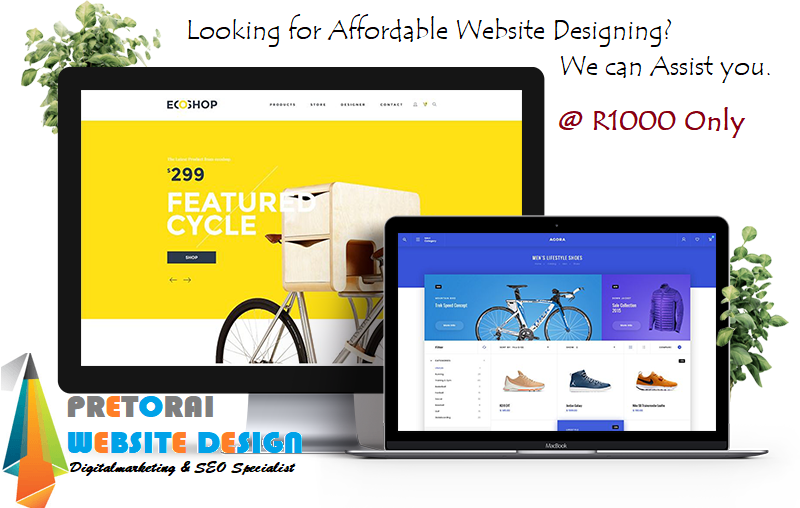The Complete Guide to Finding Top Services in Web Design Pretoria
A Comprehensive Guide to Responsive Web Style Techniques
Receptive website design has come to be an important part in the development of electronic systems, permitting a seamless customer experience throughout a multitude of tools. This overview will certainly check out critical strategies such as liquid layouts, media questions, and image optimization that add to efficient receptive style. By comprehending these concepts, developers can produce websites that not only adapt aesthetically but likewise improve user engagement. However, the landscape of internet layout is constantly progressing, questioning regarding the future of responsiveness and the approaches that will define it.
Recognizing Receptive Website Design
Receptive website design (RWD) is an approach that makes certain an internet site's format and web content adjust effortlessly throughout a range of gadgets and screen sizes (Web Design Pretoria). This layout technique is essential in today's electronic landscape, where customers accessibility web sites from mobile phones, tablets, laptops, and desktop computer computer systems. RWD improves user experience by allowing an internet site to preserve performance and looks, regardless of the device being made use of
A crucial element of RWD involves liquid grids that utilize relative devices, such as portions, as opposed to dealt with systems, to define format aspects. This flexibility makes it possible for pictures, text, and various other elements to resize proportionally, providing an optimum viewing experience. In addition, media inquiries are employed to use different designs based upon gadget features like screen size and positioning. This approach ensures that the site's layout is tailored to the particular requirements of individuals, improving functionality.
Moreover, RWD contributes favorably to search engine optimization (SEO) by advertising a solitary, consistent URL for an internet site, which simplifies link sharing and indexing. As mobile gadget use continues to rise, recognizing and implementing responsive internet layout is vital for services intending to get to a broader audience and improve general internet efficiency.
Trick Concepts of Responsive Design
To create an efficient responsive style, numerous vital concepts must be considered. A mobile-first method is crucial. This means developing for the smallest screens first and progressively improving the format for bigger devices. This technique makes certain that the important material is prioritized and easily accessible on all displays.
2nd, versatile grids and designs are important. Using a grid system that adjusts to different screen dimensions permits a harmonious circulation of web content, making sure readability and functionality across devices. This flexibility is enhanced by the use relative units, such as ems or portions, instead of fixed pixels.

Finally, focusing on content pecking order is important. Logical and clear company of web content enhances individual experience, guiding visitors with the website perfectly, no matter the device utilized. Web Design Pretoria. By sticking to these concepts, designers can create web sites that are not just aesthetically appealing however user-centered and likewise useful throughout all devices
Methods for Liquid Layouts
Liquid formats are vital for producing flexible internet experiences that seamlessly adapt to different display dimensions. By making use of percentage-based sizes instead of repaired pixel values, designers can make sure that components on a page resize proportionally, maintaining visual harmony across devices. This method promotes versatility, enabling material to adapt and stream as the viewport modifications.
One efficient technique for accomplishing liquid designs is to utilize CSS Flexbox or Grid systems. These CSS modules allow designers to create receptive frameworks that can quickly resize and reposition based upon the readily available room. Flexbox excels in one-dimensional formats, while Grid is perfect for two-dimensional setups, supplying better Homepage control over positioning and positioning.
One more technique involves using media questions to specify breakpoints where modifications are required - Web Design Pretoria. By specifying various designs for different screen dimensions, developers can customize layout residential properties dynamically, making certain ideal functionality and aesthetic allure
Furthermore, integrating relative devices like ems or rems for font sizes and spacing can better improve fluidity, as these devices range based on customer settings or moms and dad aspects. Together, these strategies help with the development of liquid designs that advertise an appealing user experience throughout diverse tools.
Optimizing Photos for All Gadgets
Images play a critical function in web style, and optimizing them for different devices is necessary for enhancing efficiency and user experience. To attain this, designers must employ receptive image methods that make certain pictures show appropriately throughout various display dimensions and resolutions.
One effective method is using the HTML" element, which permits defining numerous picture sources based on the display screen conditions. By using 'srcset' characteristics, programmers can provide various photo resolutions, enabling the web browser to pick the most suitable one for the customer's tool.
Additionally, carrying out correct file styles is crucial. Layouts such as JPEG, PNG, and WebP each offer distinct purposes and can dramatically influence packing times. WebP, as an example, offers linked here exceptional compression, causing smaller documents dimensions without sacrificing quality.
One more important facet is photo compression. Devices like TinyPNG or ImageOptim can lower file dimensions, improving loading rate while preserving visual integrity. Making use of CSS for history pictures can improve packing as they can be manipulated more fluidly across tools.
Inevitably, enhancing pictures not only enhances website efficiency however likewise contributes to better customer involvement and retention, making it an essential method in responsive website design.
Checking and Keeping Responsiveness
Making certain a seamless individual experience throughout different tools needs attentive testing and upkeep of responsiveness. The very first step in this process is to make use of a mix of manual and automated screening tools. Devices such as Google's Mobile-Friendly Examination and BrowserStack allow programmers to sneak peek how their internet sites do across numerous gadgets and display sizes effectively.
In addition, it is important to carry out routine audits of your website's layout and performance. This includes monitoring for breakpoints, guaranteeing components resize correctly, and validating that navigation continues to be intuitive. In addition, testing needs to not be limited to aesthetic aspects; performance throughout different internet browsers and devices need to be analyzed to recognize any inconsistencies.

Final Thought
Finally, the implementation of responsive web layout strategies is essential for creating adaptable web sites that boost customer experience throughout varied tools. By sticking to vital concepts such as liquid grids, media questions, and adaptable formats, along with optimizing photos and making use of receptive structures, developers can accomplish visual appeal and improved loading rates. Recurring screening and maintenance further ensure that websites remain useful and cosmetically pleasing, inevitably adding to enhanced user engagement and satisfaction.
Responsive internet style has come to be a necessary element in the development of electronic platforms, permitting for a seamless customer experience across a multitude of gadgets.Responsive internet style (RWD) is an approach that makes certain a web site's layout and material adapt effortlessly across Visit This Link a range of devices and screen dimensions. RWD improves customer experience by allowing an internet site to maintain capability and aesthetic appeals, no matter of the device being made use of.
Ensuring a smooth customer experience across different devices needs attentive screening and upkeep of responsiveness.In verdict, the application of receptive web layout techniques is vital for developing adaptable internet sites that improve user experience across varied tools.